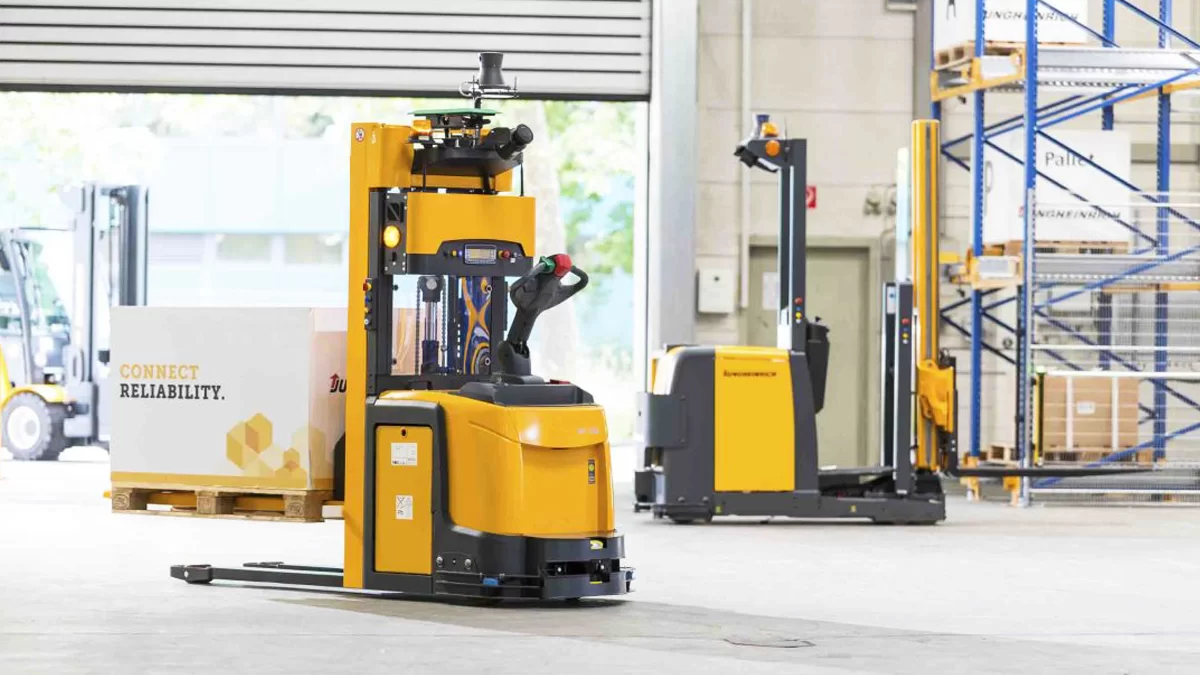
What are Automated Forklifts?
Automated forklifts, also known as autonomous forklifts or driverless forklifts, are rapidly transforming the world of material handling and warehouse management. These advanced machines utilize cutting-edge technology to navigate and perform tasks without the need for human intervention. This article will provide an in-depth look at automated forklifts, their benefits, and how they compare to other similar products on the market.
How Do Automated Forklifts Work?
Automated forklifts are designed to operate independently, relying on a combination of sensors, cameras, and advanced software algorithms to navigate their environment. These machines use LIDAR (Light Detection and Ranging) and computer vision to detect obstacles, calculate distances, and determine the most efficient routes for moving materials.
Key Components of Automated Forklifts
- Navigation system: Utilizes a combination of LIDAR, cameras, and GPS technology to determine the forklift’s location and plan its route.
- Control system: Processes information from the navigation system and adjusts the forklift’s movements accordingly.
- Safety features: Include obstacle detection, collision avoidance, and emergency stop functions to ensure the safety of workers and the surrounding environment.
Benefits of Automated Forklifts
Automated forklifts offer several advantages over traditional, manually-operated forklifts. Some of the key benefits include:
- Increased productivity: Autonomous forklifts can operate 24/7 without the need for breaks or shift changes, allowing for more efficient use of resources and faster order fulfillment.
- Improved safety: By eliminating human error and utilizing advanced safety features, automated forklifts can significantly reduce the risk of accidents and injuries in the workplace.
- Cost savings: While the initial investment may be higher, the long-term cost savings associated with reduced labor costs, fewer accidents, and increased efficiency can make automated forklifts a more cost-effective solution.
Comparing Automated Forklifts to Similar Products
In the realm of automated material handling, there are several other technologies that offer comparable solutions. Here, we will compare automated forklifts to Automated Guided Vehicles (AGVs) and Autonomous Mobile Robots (AMRs).
Automated Guided Vehicles (AGVs)
AGVs are self-guided vehicles that follow predetermined paths, typically marked by wires, magnets, or barcodes on the floor. They are commonly used for transporting materials within warehouses and manufacturing facilities. While AGVs are a step towards automation, they have some limitations compared to automated forklifts:
- Flexibility: AGVs rely on fixed paths, making them less adaptable to changes in the warehouse layout or operations.
- Navigation: Unlike automated forklifts, AGVs may struggle with navigating complex environments and avoiding obstacles.
- Lifting capabilities: AGVs are typically designed for transporting materials, not lifting and stacking them, which limits their applications compared to automated forklifts.
Autonomous Mobile Robots (AMRs)
AMRs are advanced, self-navigating robots that can perform various tasks within a warehouse or manufacturing environment. They differ from AGVs in that they do not rely on predetermined paths, instead using advanced navigation systems to find the most efficient routes. While AMRs offer several advantages over AGVs, they also have some limitations when compared to automated forklifts:
- Load capacity: AMRs typically have a lower load capacity than automated forklifts, making them less suitable for handling heavy or bulky materials.
- Complex tasks: While AMRs can be equipped with various attachments for different tasks, automated forklifts are specifically designed for lifting and moving materials, making them more efficient in this regard.
Choosing the Right Automated Forklift
When selecting an automated forklift for your business, it’s essential to consider several factors to ensure that you invest in the most suitable solution. Some key considerations include:
- Load capacity: Choose an automated forklift with a suitable load capacity for your specific material handling needs.
- Integration with existing systems: Make sure the automated forklift can be easily integrated into your current warehouse management system or enterprise resource planning (ERP) software.
- Scalability: Consider whether the automated forklift system can be scaled up or down to meet changing business needs.
- Vendor reputation: Research the reputation and reliability of the forklift manufacturer to ensure you invest in a high-quality product.
Industry Applications of Automated Forklifts
Automated forklifts have a wide range of applications across various industries. Some of the key sectors benefiting from this technology include:
Manufacturing
In manufacturing facilities, automated forklifts can streamline material handling processes, moving raw materials, work-in-progress, and finished products between different production stages. They can also help manage inventory and restock production lines, reducing downtime and increasing overall productivity.
Warehousing and Distribution
Automated forklifts are particularly well-suited for warehousing and distribution operations, where efficient material handling is crucial. They can perform tasks such as picking, packing, and shipping, as well as managing inventory and optimizing storage space. By automating these processes, businesses can increase order accuracy, reduce labor costs, and improve overall efficiency.
Retail
In retail environments, automated forklifts can be used for tasks such as restocking shelves, managing inventory, and assisting with order fulfillment. They can help retailers keep up with increasing customer demands while maintaining a lean workforce.
Food and Beverage
The food and beverage industry has unique challenges, such as maintaining strict hygiene standards and handling perishable goods. Automated forklifts can help address these challenges by reducing the risk of contamination from human contact and ensuring timely transport of perishable items.
Maintenance and Support for Automated Forklifts
Like any advanced technology, automated forklifts require regular maintenance and support to ensure optimal performance and longevity. Some key aspects of maintaining your automated forklift include:
- Preventive maintenance: Schedule regular inspections and maintenance to identify potential issues before they become more significant problems. This may include checking for wear and tear on moving parts, ensuring the navigation system is functioning correctly, and verifying that all safety features are operational.
- Software updates: Keep the forklift’s control and navigation software up-to-date to benefit from the latest improvements and bug fixes.
- Operator training: Although automated forklifts are designed to operate independently, it’s essential to have trained personnel on hand to oversee their operation, perform maintenance tasks, and troubleshoot any issues that may arise.
- Vendor support: Work closely with the forklift manufacturer or supplier to address any concerns or questions regarding your automated forklift. They can provide valuable assistance, technical support, and advice to ensure your investment continues to deliver value.
Future Trends in Automated Forklift Technology
As the technology behind automated forklifts continues to evolve, we can expect to see even greater advancements in the coming years. Some potential future trends include:
- Increased autonomy: As navigation and control systems become more advanced, automated forklifts will be able to operate with even greater independence, reducing the need for human intervention.
- Collaborative robotics: The integration of collaborative robotic technology will allow automated forklifts to work seamlessly alongside human workers, further enhancing productivity and safety.
- Machine learning and AI: The implementation of machine learning and artificial intelligence algorithms will enable automated forklifts to learn from their experiences, optimizing their performance and adapting to changing conditions.
By staying informed about the latest developments in automated forklift technology, businesses can be well-positioned to take advantage of the numerous benefits these machines offer and remain competitive in an increasingly automated world.
Conclusion
Automated forklifts represent a significant advancement in warehouse management and material handling, offering increased productivity, improved safety, and cost savings. By understanding the key components, benefits, and how automated forklifts compare to other technologies like AGVs and AMRs, businesses can make informed decisions when investing in automation solutions.
For more information on automated forklift technology, visit the Material Handling Institute (MHI) or consult scientific articles such as “A Review on Automated Guided Vehicles and Autonomous Mobile Robots” published by IEEE.







